American Impression: Two guys, 'Top Gun' and a perpetual road trip through America
How a former architecture student from Quebec and an insurance broker from Arizona City have found a life traveling America impersonating pilots from "Top Gun."
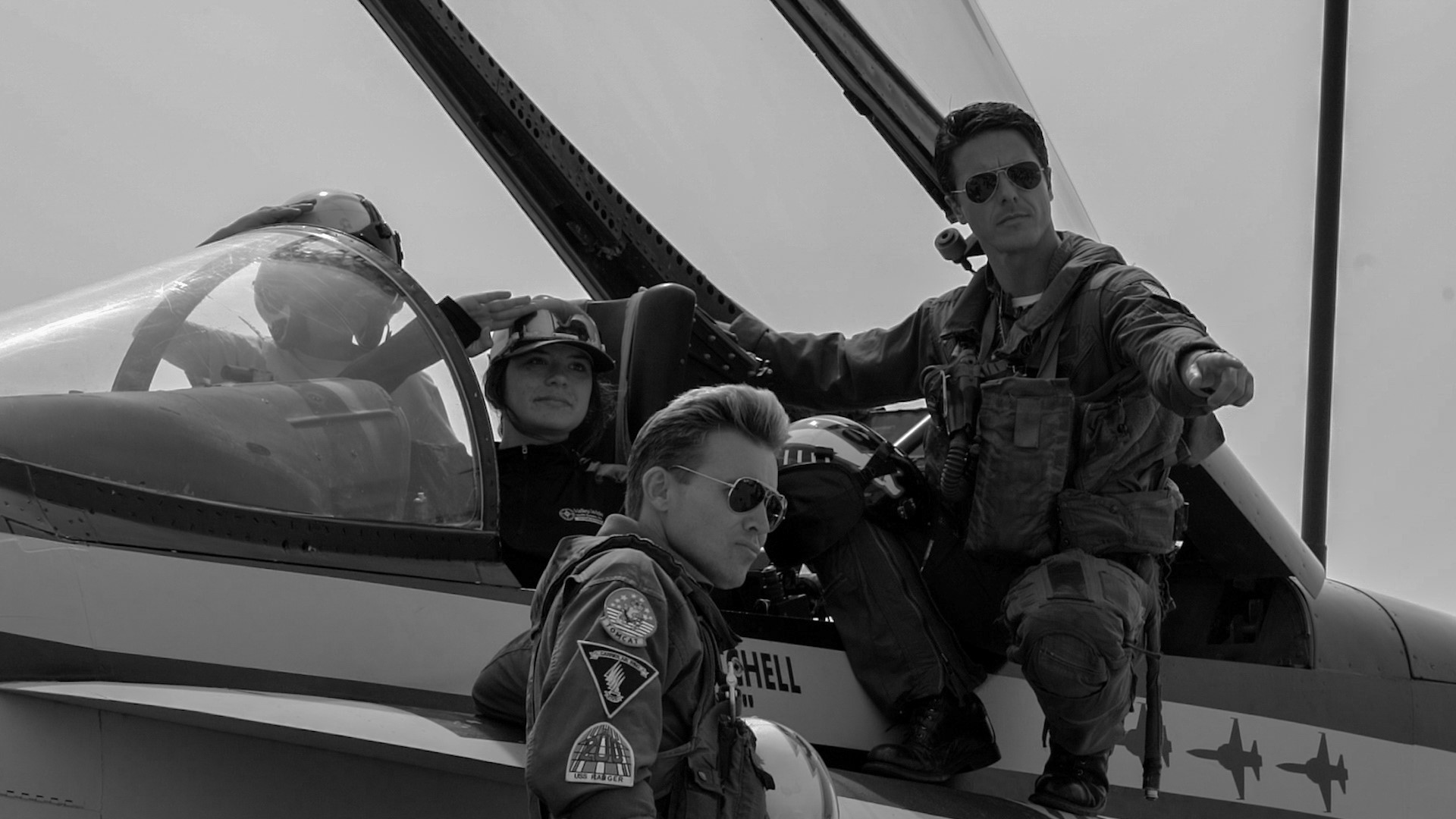
People here say the air here smells like money. It’s a constant refrain. This is the cow center of Texas and the air is heavy with the scent of manure. But if you’re a rancher or a dairyman or feedlot owner, the smell of cow stink is, in fact, the smell of money.
It’s 4 a.m., dark and hazy and stinky. Somewhere in the manure cloud, a guy who looks like Maverick from "Top Gun" is running down a mostly deserted U.S. 87, turning right out of the Holiday Inn Express driveway, past the dark Tractor Supply Co., arms pumping and heading down the commercial strip.
Or maybe he’s not. I wasn’t there to see it, I just heard about it later that morning. It could be true or it could be part of the myth. The story of a Maverick and an Iceman impersonator traveling around the country in 2023 really is a story about myths. The physical resemblance, the lines they rattle off from the "Top Gun" movies, the flight suits, the people who gather to get pictures with them: It all mingles together, fiction and non-fiction, until it becomes a self-perpetuating legend about a movie and the movie becomes real life and real life resembles the movie.
It’s a uniquely American success story built on the shoulders of a French-Canadian, a guy from the bland suburbs of Phoenix and a story that some parts of America have held tight for 37 years.
And a trip to an airshow in rural Texas puts a spotlight on it. All of it.

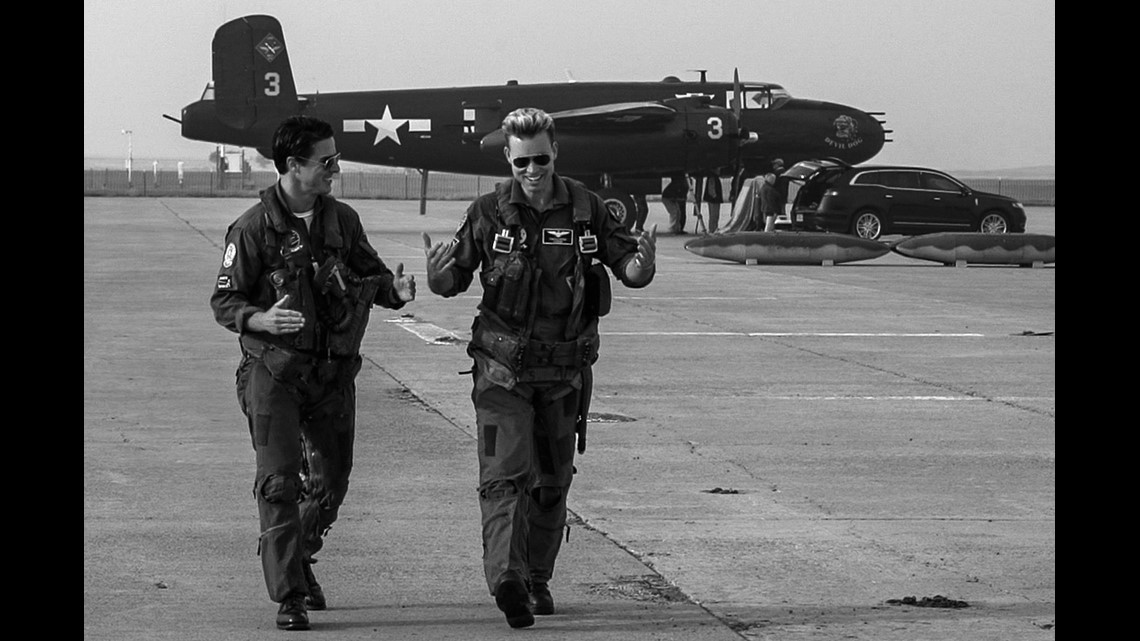
Chapter 1 The artist, Maverick
Maverick’s name is Jerome LeBlanc. He has the Tom Cruise laugh, the fist pump, the toothy smile. With those Ray-Ban Aviator sunglasses on, he’s Pete “Maverick” Mitchell, the hero of the "Top Gun" franchise.
LeBlanc grew up in Quebec, splitting his time between his mother’s home in Montreal and his father’s dairy farm four hours away. He speaks with a Quebecois lilt. When he travels, he writes letters to his children in French. They are 4 and 2. They will learn to speak the mother tongue, he says. A third child is on the way and will learn to speak the language, too.
LeBlanc can run lines like, well, Maverick. A little more tenor, a little less baritone than Tom Cruise, but you can see it and hear it. Move him off the lines, though, and you’re in Quebec. Less measured cadence, more sing-song. It feels shy and quiet.

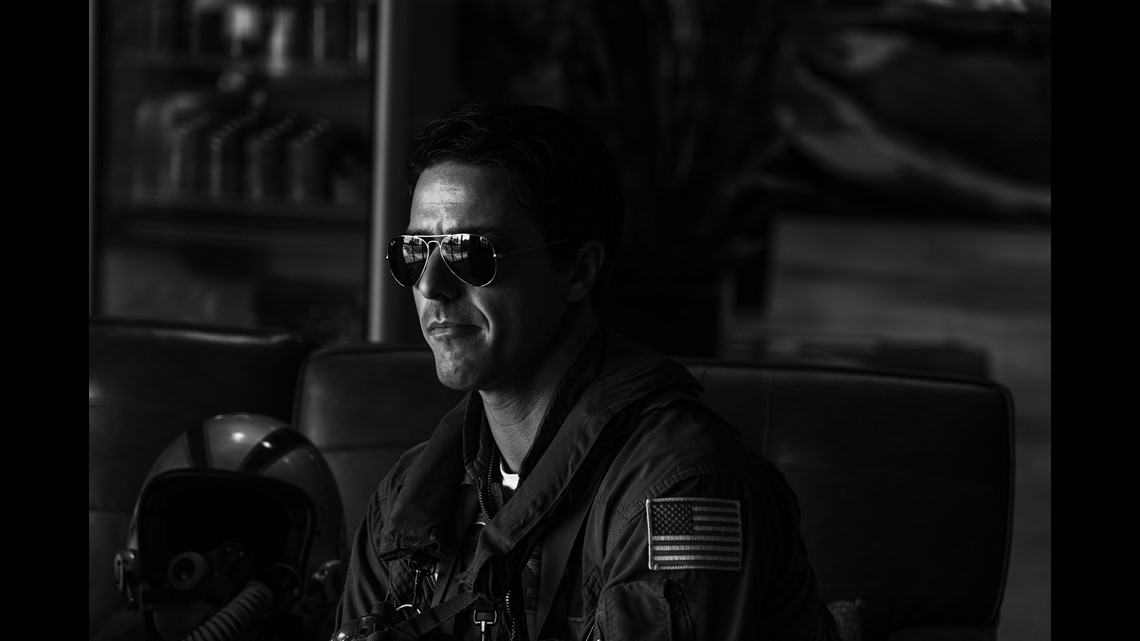
Our Maverick has the soul of an artist. He is, actually, an artist. He paints — canvases full of cars and women sitting on cars. He creates huge paintings of Maverick’s flight helmet to be auctioned off in Australia. His style is distinct: Each picture looks like it’s viewed through a wet window.
I point this out and he says, “Huh. I’ve been thinking of expanding and going abstract. Splattering paint like Jackson Pollock.”
When you live your life as an impersonator, even your own style is pliable.
Chapter 2 The Iceman of Arizona City
Tom “Iceman” Kazansky is an insurance agent in a sun-washed town south of Phoenix.
There isn’t much to Arizona City except repetitive red tile roofs, but Ice – his real name is Brian Ernst – staked out a future there nearly two decades ago. He owns buildings on the main road into town from the freeway. His insurance agency is there, along with the coffee shop he owns that one of his daughters runs. There’s a garage in one of his buildings, the local chamber of commerce, a second-hand shop and a store that is filled with the kind of painted signs you would see at Hobby Lobby if Hobby Lobby had a dirty sense of humor.
Ernst is all jawline and shoulders. He comes at you with relentless positivity.
“Someone told me once that if you help people get what they want in life, you’ll get what you want in life.”

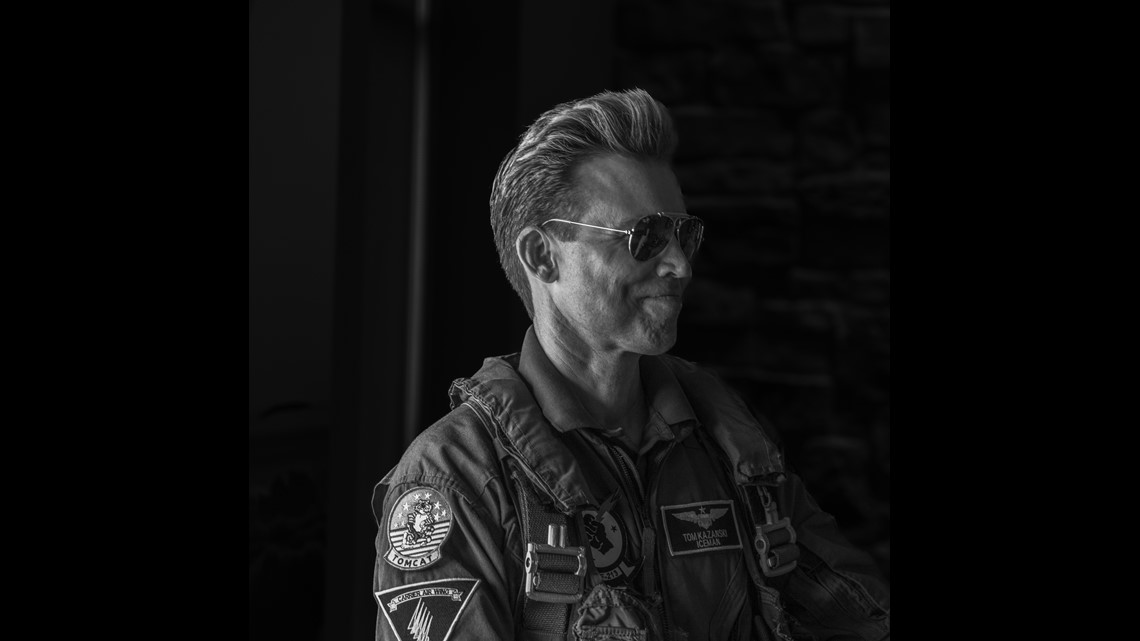
He tells me this within 20 minutes of us meeting. He tells me this three more times during our time together. He means it. Iceman wants the best for you, for me, for everyone. He loves people and helping people.
For our Iceman, service is divine.
Chapter 3 The 'Top Gun' Myth
"Top Gun" contains multitudes of myths. It was a summer blockbuster in 1986, a star vehicle for two emerging leading men, Tom Cruise and Val Kilmer, and one emerging leading woman, Kelly McGillis. It was produced by Don Simpson and Jerry Bruckheimer, Hollywood producers at the height of their power and influence after "Flashdance" in 1983 and "Beverly Hills Cop" in 1984.
The movie was smart business. Simpson and Bruckheimer managed to hold on to the soundtrack rights – and those rock-heavy cassettes were a money-making machine, the songs spending several weeks at No. 1 and making hits for Kenny Loggins, Berlin and the score’s composer, Harold Faltermeyer.
There was a massive marketing campaign – helped in part by the film’s strategic partner, the U.S. Navy, which provided planes, pilots and backdrops for the film. A pilot named Bozo flew the brawny F-14 Tomcat fighters the movie made famous. Cruise and his co-stars did many of their flight scenes in mocked-up cockpits on the ground, pretending to be in blackout-inducing turns.
There is a story that the movie raised Navy recruiting by 500%. This is part of the myth. A fact check by the Australian Associated Press found that Navy recruiting rose 8% in 1986 after the film was released. It fell by 2% the next year.


The movie came out to tepid reviews – Variety called it “revved-up but empty entertainment” – but audiences loved it. "Top Gun" helped boost overall box office receipts by 37% compared to the previous weekend. It made $180 million over the rest of the year.
"Top Gun: Maverick" was released in 2022, nearly 40 years later. The F-14s were replaced by F/A-18 Super Hornets. The actors were filmed in flight in actual cockpits. Lady Gaga had a hit off the soundtrack. There might have been fewer memorable lines, but "Top Gun: Maverick" made $1 billion in its first year.
Chapter 4 The Grind
Impersonating is grueling work. Most every weekend of spring, summer and fall of 2023 is taken up with airshow appearances. LeBlanc gets between three and 10 requests a day to appear at airshows or corporate events. They are in the places you’d expect airshows to be, ‘Merican venues. Dyess Air Force Base in Texas. Scott Air Force Base outside St. Louis. Columbus, Ohio. Duluth, Minnesota. The corporate events are everywhere, across the country and in Europe, Australia. There’s a joke in "Top Gun" about the pilots keeping foreign relations, but our Maverick actually does.
Today, he is headed to Dalhart from his home in San Diego. He is bound for Amarillo, Texas on a Thursday afternoon, clad in a white T-shirt and blue jeans and cowboy boots and sunglasses and dog tags. If you follow "Top Gun" lore, you know this is what Tom Cruise’s Maverick wore when he left a beach-volleyball game early for a take-my-breath-away encounter with Kelly McGillis.


You can say a lot of things about LeBlanc, but the man has a fanatical dedication to both character and verisimilitude.
This is part of the myth, too, the same way that LeBlanc wears sunglasses even indoors to draw a closer resemblance to Maverick. LeBlanc is Maverick. Maverick is LeBlanc.
So there he is at a car rental counter at the Amarillo airport, renting a black Toyota Camry with murdered-out logos. The clerk says, “You look like Tom Cruise.”
LeBlanc waits a beat. Flashes the Tom Cruise smile.
“Or does he look like me?”
Chapter 5 Amarillo to Dalhart
We stop at a gas station on the outskirts of Amarillo so Maverick can get a decent cup of coffee. He eats only fruits during the day, then a big protein meal during a single hour of the day. He gave up drinking.
“Everyone wants to get drunk with Maverick,” LeBlanc says. “Everybody wants to buy him a shot. It got too hard.”
He offers me some kind of supplement shot and a banana bar from Trader Joe’s. He is trying to lean out, he says, to be able to impersonate Cruise as Ethan Hunt as the new Mission Impossible movie comes out.
The miles click by. We are Iceman-less.
The schtick is that they are wingmen (“You can be my wingman anytime!” “Bull****. You can be mine!”) but LeBlanc runs the operation. He has a business of being Maverick – California Tom Cruise, LLC – managed by his wife (whose name is Nicole, in a spate of cosmic alignment). Maverick always drives the rental car and the golf carts they are provided at shows. He makes the travel reservations.
This day, he made them for the wrong date.
Iceman is stuck in Austin waiting for a connection on one of the few flights going to Amarillo after a mad scramble to fix the mistake.
Life as an impersonator is grueling; Iceman gets stranded at the Dallas airport every third trip or so.
The Camry rolls past the scrub-filled ranches of the Texas Panhandle, different shades of chinos punctuated by cows and broken up by little towns made up of a convenience store, a few homes and a grain elevator. They remind Maverick of rural Quebec where he grew up.
We are talking about LeBlanc’s skincare routine. Because, really, his skin is fantastic. He is 33 and tan and it is smooth as porcelain.

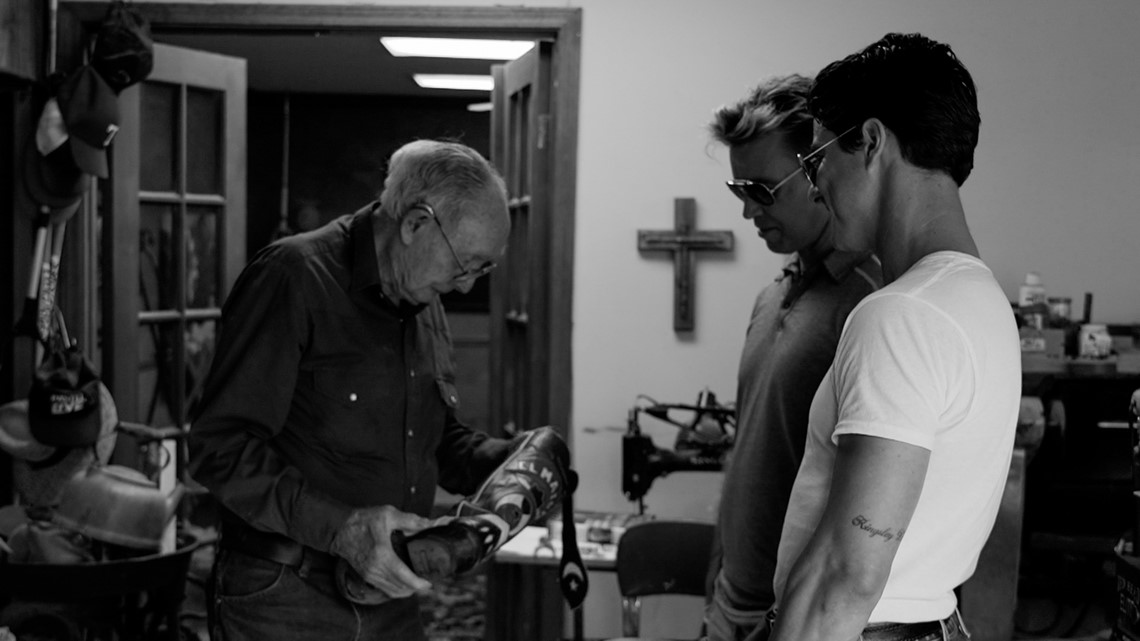
“When I was a teenager,” he says, “I had terrible acne. I got very disciplined and stopped eating pizza and sweets and sugary things. It didn’t help. As I got older, I realized it was just hormones.”
But he stayed disciplined. Travels with a dozen different bottles of vitamins and supplements that he lines up in a neat row on his hotel room dresser.
He talks about the health benefits of drinking water. LeBlanc has taken acting classes. His father-in-law is from New Jersey and talks like it, he says. So when he tells me about water, the Quebecois sing-song and the lilt crash into that Noo Yawk “A” at the end of “water.”
“I drink a lot of … watah,” he says, and then breaks into the Tom Cruise laugh.
It is an authentic impersonation of an impersonation inside an impersonation. Jerome as Maverick and Maverick as Jerome with a little bit of Joe, his father-in-law, thrown into the mix.
Chapter 6 In Character
The next day, Maverick and Iceman – who got in about 11 p.m., though you wouldn't know it by his energy level – are walking around the mostly empty streets of downtown Dalhart. They are looking for a Western store to get some boots for Iceman.
LeBlanc is back in the T-shirt and jeans. Ernst is in a polo shirt and jeans. It is overcast. They are both wearing sunglasses.
They try on hats in the first store, white and wide-brimmed (“Like Wolfman,” LeBlanc says, a reference to one of the minor pilot roles in the original film). They can’t find boots in this first store.

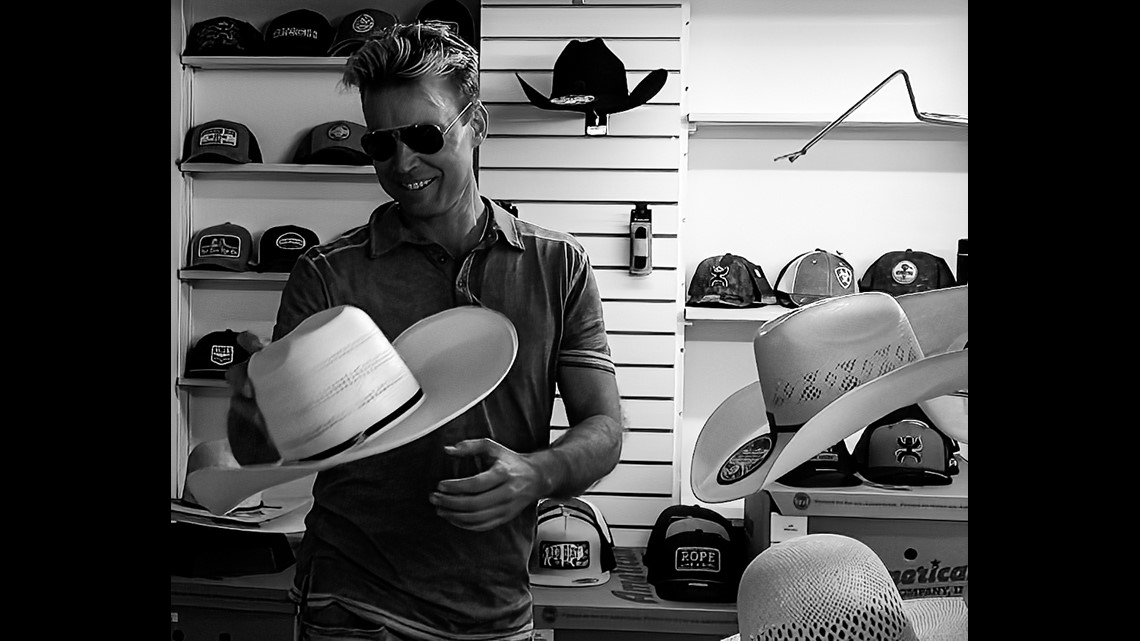
The clerk is maybe 22. Ernst tells her they’re here for the airshow.
“Are you guys pilots?” she asks.
“Yes,” Iceman says.
“Kind of,” Maverick says.
LeBlanc has been playing Maverick since he was 20 and went out to Los Angeles’ Hollywood Boulevard to earn some cash while pursuing an architecture degree at UCLA. Ernst has been Iceman for six years, since the two men met at the San Diego bar used as a set in "Top Gun." The biggest difference between them is that LeBlanc slips between himself and Maverick easily. Once Ernst puts on the Ray-Ban Shooter sunglasses, it’s All Iceman All The Time.
We leave the store and I bear witness to an intense and very detailed conversation about what kind of cowboy boots Iceman would wear, if Iceman would wear cowboy boots at all.
That is a lie. There is no question in this conversation in the cow capital of Texas that Iceman would wear boots.
Chapter 7 That Loving Feeling
Ernst leans into Iceman. It’s the jawline, but it’s also running the lines.
We have found a custom boot shop in downtown Dalhart and Ernst is telling the 92-year-old bootmaker that he is their wingman.
No recognition of the line. None at all.
He talks about being in Dalhart to help “bring back that loving feeling.”
Still nothing.
But that line about the loving feeling – that’s the "Top Gun" holiest of holies right there. It’s one of the most famous scenes in the movie, when Cruise and co-star Anthony Edwards serenade McGillis’ character (in the same bar where LeBlanc and Ernst later met, no less).
The “loving feeling” line is a foundation of the impersonation. It slips in everywhere.
A woman at an airshow doesn’t want to take a selfie with Mav, Ice and her husband? “We’ll make you look good,” Ernst says. “We’ll bring back that loving feeling.”

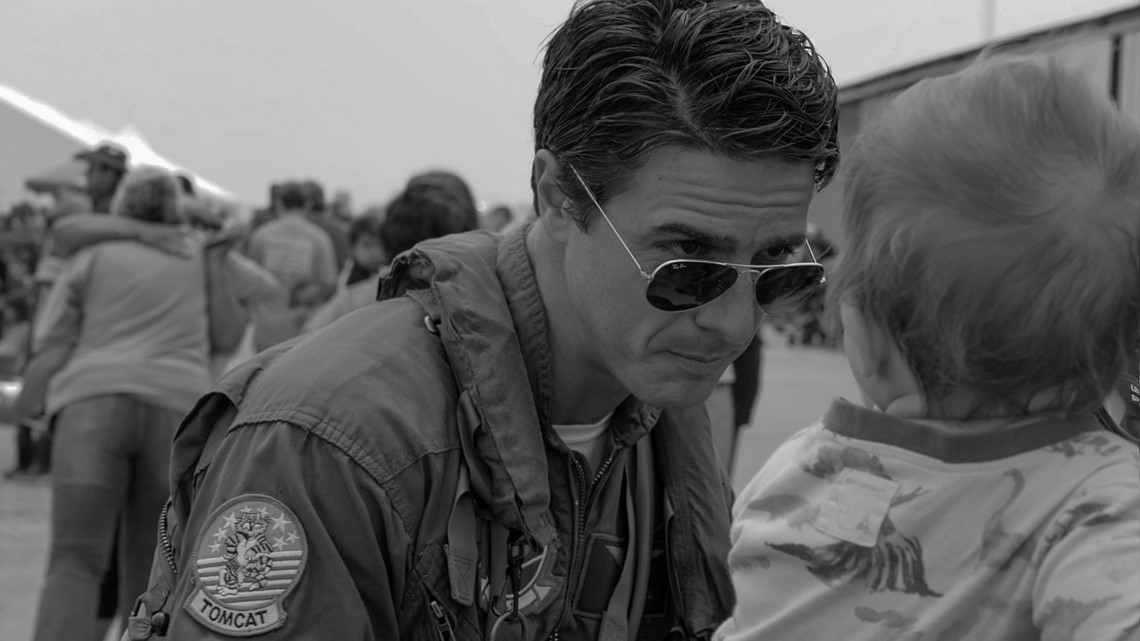
Trustee inmates from the local prison are helping set up the airshow grounds and stop to chat.
“We’re here to bring back that loving feeling,” LeBlanc tells them.
But here’s the thing: It’s true.
Chapter 8 Growing the Myth
Her name is Amy and she teaches at the private Christian academy in Dalhart. She wears fashionable sunglasses and has the air of someone who can cook dinner and kick butt in the same half hour. But she’s a little shy when she runs into Maverick and Iceman at the airshow.
“You were my crush,” she says to Maverick. “You,” she says, turning her head to Iceman, “I don’t like you. You were mean to him.”
Everybody laughs. It’s picture time.
They pose, someone yells, “Where are your hands, Amy?” and everyone laughs again.
Amy and her kids move out of the way.
A line to take pictures with Mav and Ice has queued up.
Ernst says this happens at every airshow: If they don’t keep moving, crowds form and they can never get anywhere. It certainly is happening in Dalhart. It’s about 200 yards from where they started walking to where they’re trying to end up. It takes 90 minutes to cross that distance. This is old hat for Maverick and Iceman. For the people who live in Dalhart, it’s the opportunity to touch something that looks like it walked off the big screen. Part of the strength of myth comes from participation: Each time someone shares in the myth, it grows stronger, creating more a life of its own.

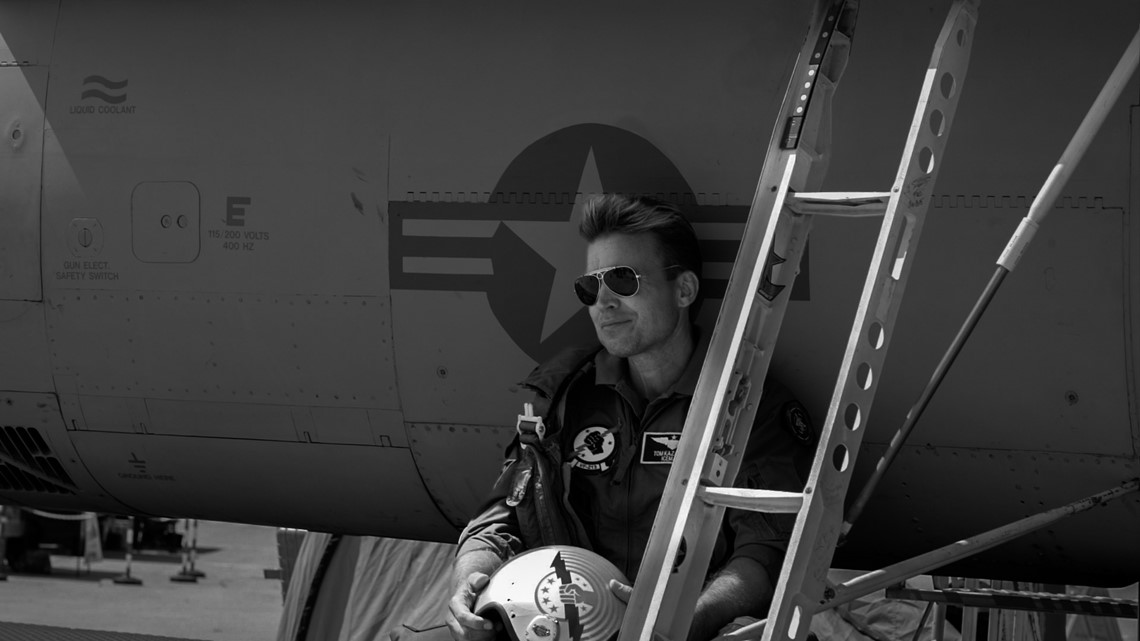
The modern myth is the same. Post that photo with the guys from a movie from 37 years ago that still occupies part of the zeitgeist, put it on social media, get the likes, feed the algorithm. The myth expands.
Someone wants a picture. Someone else wants a picture. A little kid asks Maverick for his autograph (LeBlanc carries cards in his flight suit for just this moment), and his dad wants a picture, too. About 10 people line up in less than two minutes. Everyone wants a picture.
Sometimes a smartass comes by and says, “Sorry about Goose.” A reference to the Edwards character who dies in the original film, setting up a grieving Maverick in the second act, a redemption arc in the third and the entire premise of the sequel. LeBlanc, who has heard this about a million times, is gracious and understated, says thank you, that’s very kind and enjoy the airshow.


Mostly, though, it’s about 30 seconds or a minute of interaction each. Shake hands, pose, thumbs up, enjoy the show.
Post that selfie on Instagram or the video on TikTok.
The guys do it for the ‘Gram a lot. LeBlanc has nearly 1 million followers on TikTok, more than 100,000 followers on Instagram. His videos get massive amounts of views: A video of the two of them in a golf cart at the Columbus, Ohio, airshow earlier this year has gotten more than 10 million views on Instagram.
Social media is the modern mythmaker and Mav and Ice are social media machines. They are hired to walk around and be social. They see what they do as a way of helping the merchants, getting people in the door.
“We do whatever we need to do to get people to come,” Ernst says. We’re walking over to a shaved ice stand. LeBlanc is talking to the owner, plotting out the script for a promotional social video.
“You can say ‘Hey, Iceman, which flavor you got?’” A pause. “I thought you were more … vanilla.”
Cue the Tom Cruise laugh.
Put the hashtags on. Post it on the ‘Gram. The "Top Gun" myth started before social media but it was made for it.
LeBlanc has been banned from Instagram five times because the app’s terms of service say you’re not supposed to pretend to be someone you’re not.
That’s why all his posts start with “Not Tom Cruise – Jerome LeBlanc here…”
Chapter 9 Dinner Without Eating
We go to dinner at a local steakhouse. Ernst is in the polo shirt and jeans from the boot adventure. LeBlanc is in the T-shirt and blue jeans and dog tags, but has added the nylon flight jacket Maverick wore in the second film.
You know they are both wearing sunglasses.
Every head in the room turns. This must be what it’s like to date models. All the attention on your companions.
We sit in a back room and the owner brings person after person over for pictures.

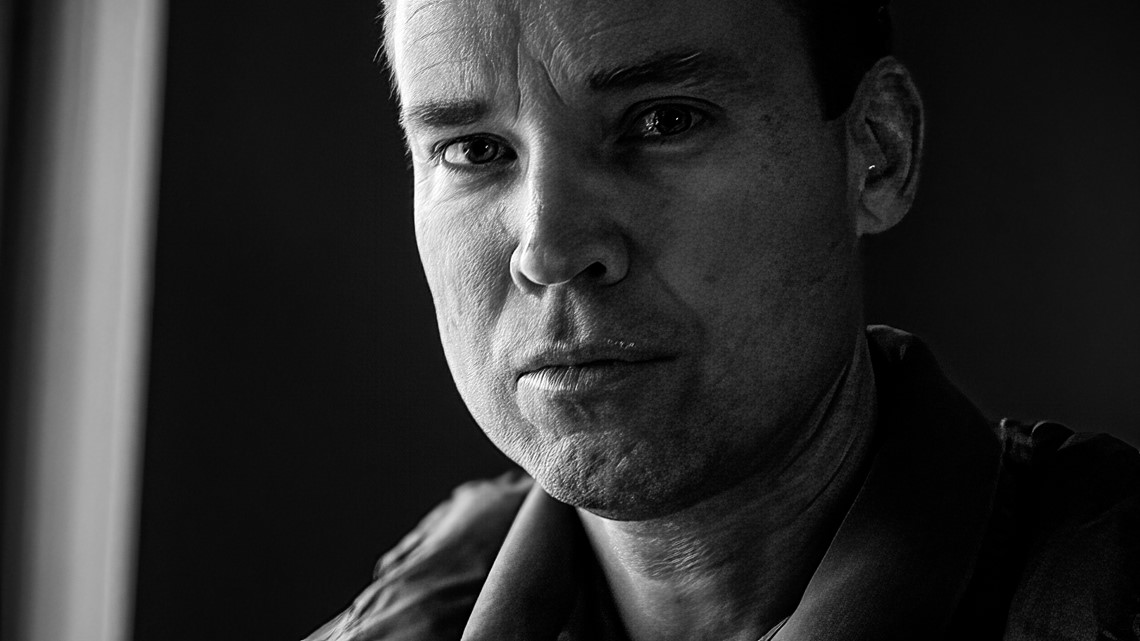
Smile for the phone camera, thumbs up, thanks for coming over, hope to see you tomorrow at the airshow.
I know LeBlanc isn’t going to eat. I ask Ernst if he will.
“I don’t like to eat during these weekends,” he says. “My body processing food takes energy and I need to put that energy into what I’m doing.”
Another group comes over. And another. Finally, the guys just walk into the main dining room, working their way through it, posing for selfie after selfie.
Chapter 10 The Need for Speed
It’s the last morning of a two-day airshow. Saturday was hot and Sunday will be hot again.
It’s overcast and the air is thick with the smell of money.
The Camry with the murdered-out logo is idling out front of the Holiday Inn. Maverick is, of course, driving. His sunglasses are on.
Ernst – his sunglasses are off – slides into the front seat and plays with his phone for a minute.
Jodi Rueger, a stunt pilot catching a ride to the show, is in the back seat. Ernst turns and says, “I need something to get myself up.”
He presses a button on his phone and “Danger Zone” by Kenny Loggins comes on.
“Don’t you get sick of this?” Rueger asks, laughing. “I would get so sick of this.”
Ernst slides his glasses on. Looks forward. And says something, with all the confidence of Iceman and all the assurance he’s building a myth.
“Never.”
Inspiring Arizona

